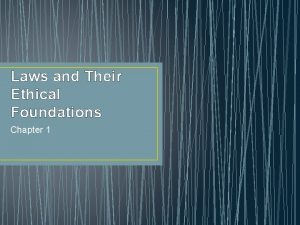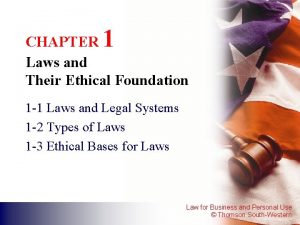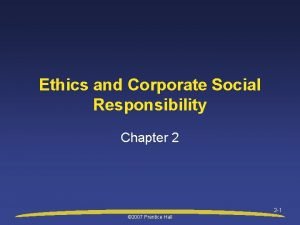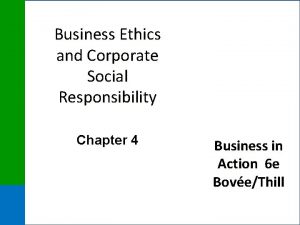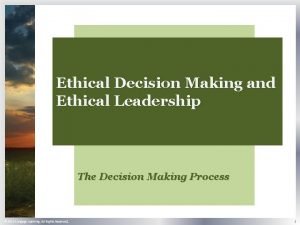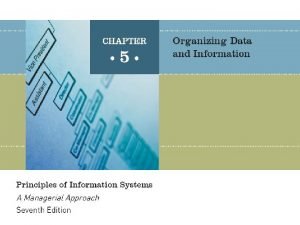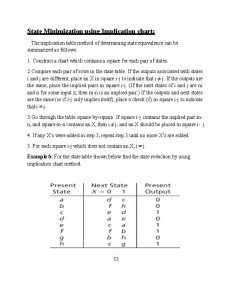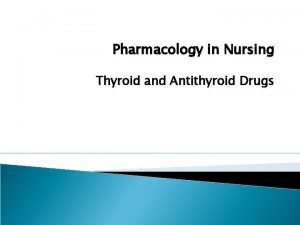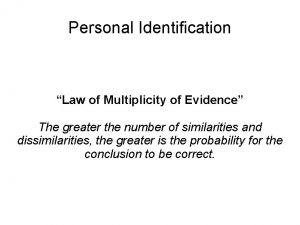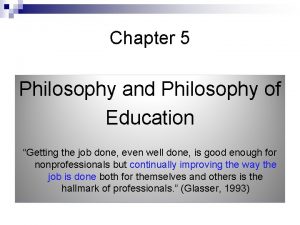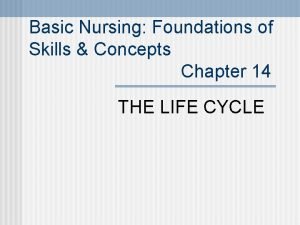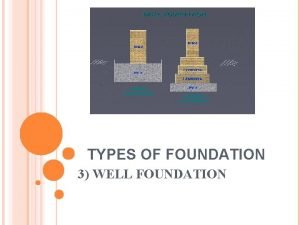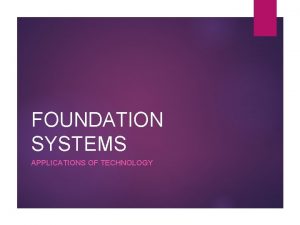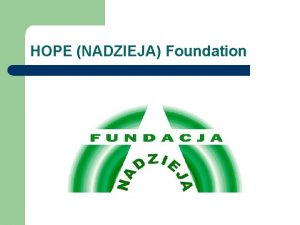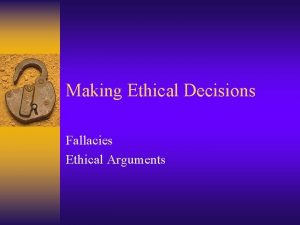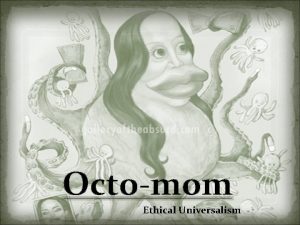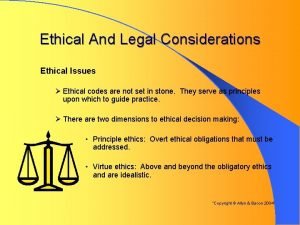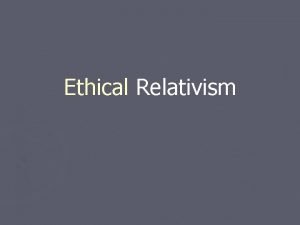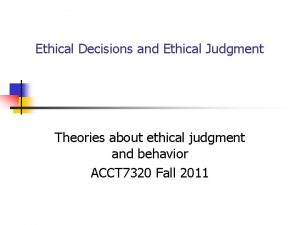Fourth University Foundation Ethical Forum Ethical Implications of





















- Slides: 21

Fourth University Foundation Ethical Forum Ethical Implications of Patenting Academic Research Economic evidence: the real effect of incentives Paul Belleflamme CORE and Louvain School of Management - Université catholique de Louvain

Plan n n Question: Does intellectual property fulfill its mission? Theoretical background n n n How to answer? n n n Why IP protection? Alternatives? How to measure innovation? Is there a link between recent strengthening of IP protection, increase in patent grantsand increase in R&D? Results n n n Difficult to establish non ambiguous results "Patent paradox" "Market for technology"? 4 th Ethical Forum © Paul Belleflamme, 2005 2

Theoretical background n Basic problem of innovation n Incentive problem within the relationship between one principal (society) and one agent (potential innovator) in order to produce a public good (knowledge). Induce innovation if social expected value exceeds social expected cost. If so, create sufficient incentives for the innovator so that private expected compensation exceeds private expected costs. IP must be particularly protected when • creation process is costly (either financially or in terms of opportunity costs); • research is risky (the probability of innovation is low). n When it comes to design the appropriate way to protect IP, the complexity is of a quantitative rather than qualitative nature: n Level and structure of the rent to be left to the innovator? 4 th Ethical Forum © Paul Belleflamme, 2005 3

Economic rationale of IP rights n n n Non-excludability means no sales, and no sales might mean no production risk of underproduction To solve the underproduction problem, innovators are awarded by the law the exclusive right to control the production and the sales of their goods. Generates an underutilization problem: n n Monopoly price > marginal cost (= zero) consumers who are willing to pay more than zero but less than monopoly price don’t consume inefficiency IP laws strike a balance between the two conflicting problems n n The exclusivity created by copyright or patents is limited in length and in breadth. This balance is necessarily imperfect! 4 th Ethical Forum © Paul Belleflamme, 2005 4

Economic rationale of IP rights (2) n Trade-off between INCENTIVES & USE Dynamic efficiency Static efficiency Infinite protection No protection Balance is unavoidably imperfect 4 th Ethical Forum © Paul Belleflamme, 2005 5

Alternative solutions n Subsidy : government finances technical and artistic creation n static efficiency : free access no deadweight loss, but taxation distorsions dynamic efficiency : uncertainty about costs/benefits of research subsidy might give too little (too much) incentive Secrecy : no need for public intervention n n information is still non-rival but the absence of diffusion creates a cost for society offers no protection against independent innovations 4 th Ethical Forum © Paul Belleflamme, 2005 6

Some trends n IP protection : US and Europe have… n n strengthened IP law, sought to harmonize it internationally, and extended its coverage to new areas. Number of patent grants n n n (since early 1980 s) more than 3 x in the USA between 1980 and 2001 (but stable over the previous two decades). comparable trend in Europe Innovation rapidly Is there a link between these trends? 4 th Ethical Forum © Paul Belleflamme, 2005 7

How to measure innovation? n n n Few available indicators of technology output. Patent indicators are the most frequently used. But n n no standard method of calculating indicators from patent data analytical and policy lessons that can be drawn from patent indicators are widely divergent OECD tries to standardize these indicators. Advantages of patent indicators n n Patents have a close link to invention. Patents cover a broad range of technologies on which there are sometimes few other sources of data. The contents of patent documents are a rich source of information (on the applicant, inventor, technology category, claims, etc). Patent data are readily available from patent offices. 4 th Ethical Forum © Paul Belleflamme, 2005 8

How to measure innovation? (2) n Disadvantages of patent indicators n n n The value distribution of patents is skewed as many patents have no industrial application (and hence are of little value to society) whereas a few are of substantial value. Many inventions are not patented because they are not patentable or inventors may protect the inventions using other methods, such as secrecy, lead time, etc. Propensity to patent differs across countries and industries. Differences in patent regulations make it difficult to compare counts across countries. Changes in patent law over the years make it difficult to analyse trends over time. Nevertheless, in the absence of a “perfect” innovation output indicator, patent indicators are the best available indicators of innovation. 4 th Ethical Forum © Paul Belleflamme, 2005 9

How to measure innovation? (3) n How to refine the measure of innovation given by patents? n Weigh each patent for the number of citations it generates in subsequent patents • Measures knowledge externalities • BUT, not all citations have the same value (only ½ correspond to a genuine flow of knowledge, only ¼ to a decisive flow of knowledge) n Use renewal efforts or the filing of a legal opposition to the patents • It is expensive for holders of European patents to renew patent protection for one year. Similarly, legal battles are costly. So, only privately valuable patents are worth renewing or opposing. n Interviews of inventors • "What is your best guess of the minimum price at which the owner of the patent would sell the patent right to an independent party on the day in which the patent was granted? " (Gambardella, Harhoff & Verpagen, 2005) 4 th Ethical Forum © Paul Belleflamme, 2005 10

Patent as indicators - Highlights See Compendium of Patent Statistics 2004, http: //www. oecd. org/dataoecd/60/24/8208325. pdf n Over the past decade, sharp increase in the level of patent activities across the world. n Reflects growing importance of patents for IP protection Number of patent applications n 1991 2000 EPO 60 104 109 609 USPTO 107 039 179 658 In all fields, but especially in biotechnology and ICT. %age increase in patent applications to EPO (1991 -2000) Biotechnology 10, 9% Information and Communication Technologies 9, 5% All fields 6, 5% 4 th Ethical Forum © Paul Belleflamme, 2005 11

Highlights (2) Source: Lévêque, F. and Ménière, Y. (2004). The Economics of Patents and Copyright. The Berkeley Electronic Press. 4 th Ethical Forum © Paul Belleflamme, 2005 12

Highlights (3) n Patenting is concentrated in a small number of countries. n n France, Germany, Japan, the UK and the US accounted for 83% of the triadic patent families (i. e. , a set of patents taken at the EPO, JPO and the USPTO) in 2000. However, patenting activity of developing countries such as China, India and Brazil increased rapidly during the 1990 s. The patent intensity (triadic patent families as a percentage of industry-financed R&D) of the EU and the US increased from the early to mid-1990 s (but has started to decline in recent years). Internationalisation of technology has increased over time as reflected by an increase in the share of technology owned by firms of another country than the inventor’s country of residence. 4 th Ethical Forum © Paul Belleflamme, 2005 13

4 th Ethical Forum © Paul Belleflamme, 2005 14

Do firms use patents? Why? n Except for the chemical and pharmaceutical sectors, patent protection is generally deemed as of little efficiency. n n Innovating firms consider trade secrets (for process innovations) and business strategies based of early-mover advantage (for product innovations) as the main means of getting returns on R&D investments and to appropriate the rents stemming from innovation. (Caillaud, 2003) Managers claim that "lead time, learning curves, and sales or service efforts are substantially more effective in protecting IP than patents are. '' (Anand Galetovic, 2004) n Explanations? Firms consider that a patent … n n n can easily be 'invented around' by imitators, is costly to obtain and to enforce, is detrimental because of the disclosure requirement. 4 th Ethical Forum © Paul Belleflamme, 2005 15

Do firms use patents? Why? (2) n Why do firms in most sectors still bother to seek patent protection for their inventions? ? ? n n Patents are relatively inexpensive to register (although they are generally costly to defend). Patents can serve to measure the ouput of a firm's R&D division and, thereby, to structure compensation and incentive schemes. Venture capitalists often demand that firms patent technology, both to block rivals and to have assets to sell in case the firm flouders. "Patent portfolio theory" • The more the merrier • The true value of patents lies not in their individual worth, but in their aggregation into a collection of related patents. 4 th Ethical Forum © Paul Belleflamme, 2005 16

Patent portfolios n Patents can be used as a 'trading device' or 'bargaining chip'. n n Confirmed by a number of surveys. Essentially large firms resort to patent protection Especially in complex industries (e. g. , electronics and software) where innovation is cumulative. "Patent paradox" n Facts in the semiconductor industry, 1979 -1995 (Hall & Ziedonis, 2001) • Firms do not rely heavily on patents to appropriate returns to R&D. • Yet, their propensity to patent has risen dramatically since the mid-1980 s. n n Interviews with industry representatives Main results • The 1980 s strengthening of U. S. patent rights spawned "patent portfolio races" among capital-intensive firms, • but it also facilitated entry by specialized design firms. 4 th Ethical Forum © Paul Belleflamme, 2005 17

Patent portfolios (2) n Some facts and figures (The Economist, October 20, 2005) IBM now earns over $1 billion annually from its IP portfolio n HP's revenue from licensing has quadrupled in less than three years, to over $200 m this year. n Microsoft is on course to file 3, 000 patents this year, when in 1990 it received a mere five. n 54% of companies saw growth in licensing of 10 -50% between 2000 and 2002. Almost 75% of executives say they expect to buy as well as sell more licences over the next two to five years, and 43% expect a dramatic increase in their licensing revenue (survey by Mc. Kinsey). n 4 th Ethical Forum © Paul Belleflamme, 2005 18

Patent portfolios (3) n Explanations n n n Complexity of industries (e. g. , biotech, IT, telecoms) greater willingness to accept the innovations of others. New technologies quickly turn into commodities firms increasingly rely on innovation to remain competitive. Demand for interoperability and common standards different firms' technologies must work together smoothly requires pooling patents or cross-licensing agreements (e. g. , MPEG 2) Generating IP is less capital-intensive makes it attractive to many start-up firms, but venture capitalists demand patents as assets that can be sold in case of failure. Many companies are acquiring large numbers of patents for purely defensive reasons, for use only to keep others' patent threats at bay. "Prisoners' dilemma" or "balance of power" argument. 4 th Ethical Forum © Paul Belleflamme, 2005 19

Effects on innovation? n Increase in patents AND in spending on R&D n n n Rule of thumb: tech companies file almost 2 patents for every $1 m they spend on R&D. But, But in IT industry, it is worrying that the growth in the number of patents exceeds the increase in R&D expenditure ("cheap" patents? ) Does the proliferation of patents impedes or speed up innovation? n n Impedes: Impedes "tragedy of the anticommons", second "enclosure movement", higher transaction costs encumbrance to businesses Speeds up: up more incentives to innovate, more economic specialisation creation of a proper "market for technology" 4 th Ethical Forum © Paul Belleflamme, 2005 20

Effects on innovation? (2) n n "There is certainly a level of mutually assured destruction among the big companies. If you build up your patent portfolio, I build up mine—nukes pointing at each other. " "That has exactly the right outcome. We sit here and exchange patents with each other. Ultimately, that's great: you have a set of companies doing more innovation than they would have otherwise. " (Mr Papadopoulos at Sun Microsystems, in The Economist, October 20, 2005) 4 th Ethical Forum © Paul Belleflamme, 2005 21
 Case study ethan and college expenses
Case study ethan and college expenses Pad foundation
Pad foundation Foundation standard 1 academic foundation
Foundation standard 1 academic foundation Chapter 1 laws and their ethical foundation
Chapter 1 laws and their ethical foundation What is ethical foundation
What is ethical foundation Laws and their ethical foundation
Laws and their ethical foundation Perbedaan ethical dilemma dan ethical lapse
Perbedaan ethical dilemma dan ethical lapse Ethical lenses army
Ethical lenses army Perbedaan ethical dilemma dan ethical lapse
Perbedaan ethical dilemma dan ethical lapse Ethical habits
Ethical habits Database approach to data management
Database approach to data management Constructivist approach
Constructivist approach Implication chart method
Implication chart method Nursing implications for synthroid
Nursing implications for synthroid Adjust for multiplicity
Adjust for multiplicity How audience negotiate meaning in mil
How audience negotiate meaning in mil Marketing implications
Marketing implications Tautological implication
Tautological implication Mathmatical proposition
Mathmatical proposition Essentialism and perennialism
Essentialism and perennialism Consumer behavior cengage
Consumer behavior cengage Nursing implications
Nursing implications



